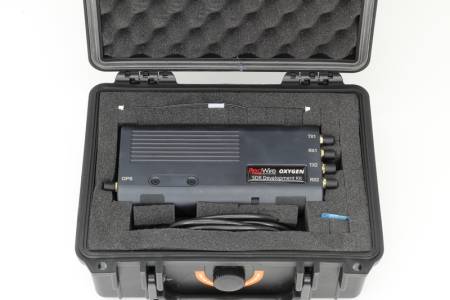
Features
-
70 MHz to 6 GHz
-
Xilinx Ultrascale+ MPSOC FPGA
-
Analog Devices AD9361
-
2 USB-C interfaces (1 Upstream Facing Port, 1 Dual Role Port) supporting USB 3.0 speeds
-
2 Phase coherent RX channels
-
2 Phase coherent TX channels
-
Expansion socket for optional RF daughtercards (LNAs, mixers, etc.)
-
Internal GPS (requires external 3.3V active antenna)
-
12 External 1.8V GPIOs available with a standard pluggable connector
General Description
The Oxygen SDR is the first commercially available software defined radio (SDR) released by Red Wire Technologies (RWT) and is built upon an ecosystem of components intended to facilitate the rapid deployment of custom SDRs for mission-specific applications. RWT has generated an initial development board set, the RWT Oxygen SDR Development Kit, to demonstrate how these components can be assembled into a fully embedded fieldable SDR.
Oxygen SDR can be used to either stream data to a host computer as an iio device over USB gadget ethernet or to operate as a standalone embedded computer. The operating system for the radio is a custom Linux distribution built using the Yocto/OpenEmbedded development system. The development kit includes several options of Xilinx FPGA sizes to allow users to optimize power consumption and performance for their applications. The default RF transceiver card is based on the Analog Devices AD9361 and provides 2TX/2RX MIMO support. Other RF transceiver cards are currently in development and will allow for additional options in the future. The Oxygen SDR includes an integrated GPS receiver, a real time clock, and 12 externally accessible 1.8V GPIO signals.
In addition to the radio's standard features, an expansion socket is provided to host application specific RF personality boards if needed. These personality boards are intended to provide additional RF signal processing (e.g., up/down converters, low noise amplifiers, power amplifiers, filters, etc.). Personality boards can be developed by RWT or by customers. All of the physical and electrical specifications required to develop personality boards for this expansion socket are provided on the Oxygen Specifications page.
-
For information on starting to use the Oxygen SDR see: Oxygen Getting started
-
For advanced information on building a custom Linux distribution
-
For information on specifications see: Oxygen Specifications
-
For information on creating a sdcard see SD card creation
-
For information on the console port see Console Port
FPGA Options
| Option | FPGA | ARM A53 Cores | Mali GPU | H.264/5 VCU | Logic Cells | DSP Slices | Block Ram | Ultra RAM |
|---|---|---|---|---|---|---|---|---|
| 2CG | XCZU2CG-1SFVC784 | Dual (1.3GHz) | - | - | 103k | 240 | 5.3Mb | |
| 3CG | XCZU3CG-1SFVC784 | Dual (1.3GHz) | - | - | 154k | 360 | 7.6Mb | |
| 4CG | XCZU4CG-1SFVC784 | Dual (1.3GHz) | - | - | 192k | 728 | 4.5Mb | 13.5Mb |
| 2EG | XCZU2EG-1SFVC784 | Quad (1.5GHz) | Y | - | 103k | 240 | 5.3Mb | |
| *3EG | XCZU3EG-1SFVC784 | Quad (1.5GHz) | Y | - | 154k | 360 | 7.6Mb | |
| 4EV | XCZU4EV-1SFVC784 | Quad (1.5GHz) | Y | Y | 192k | 728 | 4.5Mb | 13.5Mb |
*Standard configuration ships with the 3EG option. All FPGAs have 2GB DDR4 RAM and 128 MB SPI Flash
FPGA Utilization
An HDL development environment has been created that is similar to a GNU Radio out-of-tree module to allow some or all of the user signal processing algorithms to be implemented in the logic fabric. This results in a significant performance boost and more deterministic timing for applications such as CDMA and TDMA waveforms. Whether the radio is used as an iio device or a standalone embedded system using gr-rwt, there is ample remaining FPGA space for user code development.
Kit Contents
The standard Oxygen SDR kit comes packed in a hard sided case with the following contents:
-
Oxygen Software Defined Radio
-
100-240 VAC, ~50/60Hz to 12 VDC, 3A wall wart power supply with north american NEMA 5-15P plug
-
USB-A to USB-C cable
-
USB-C to USB-C cable
-
GPIO port cable (Molex part number 0151341402)
-
32 GB microSD card, preloaded with boot image and example code
-
Console/Debug port header extension connector (Samtec ESQ-106-44-L-D)


In addition to the standard configuration, the Oxygen SDR can be ordered without an enclosure.

